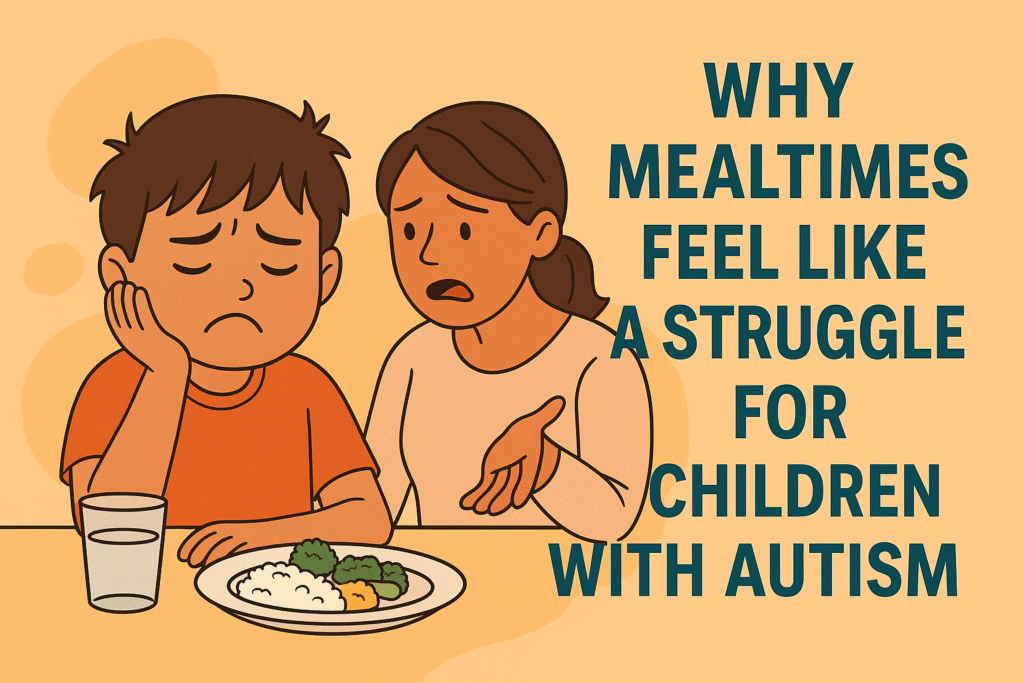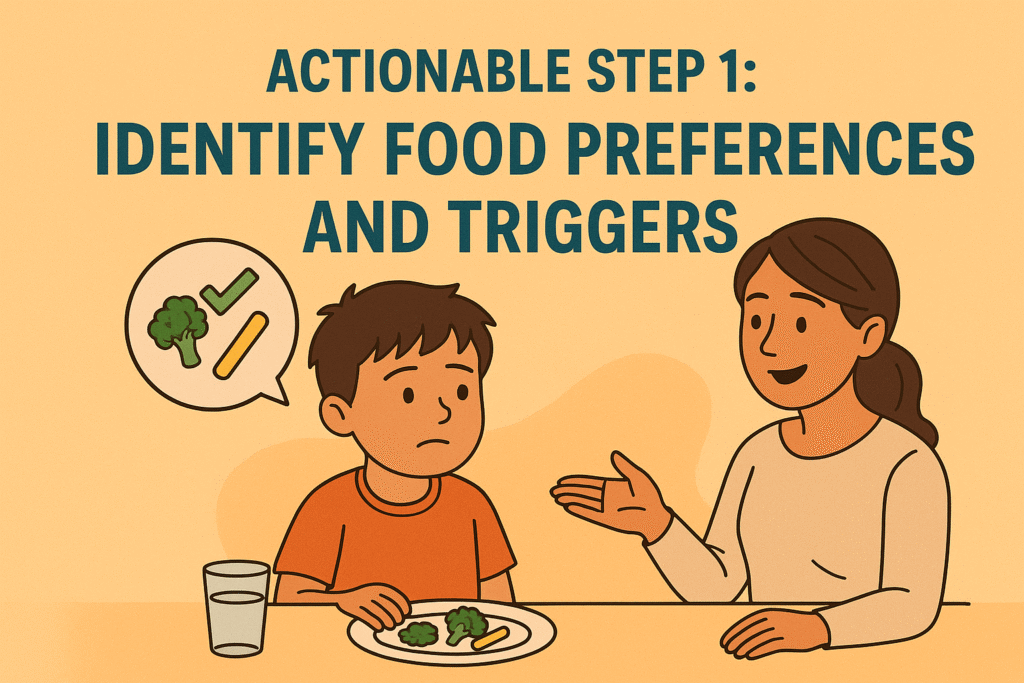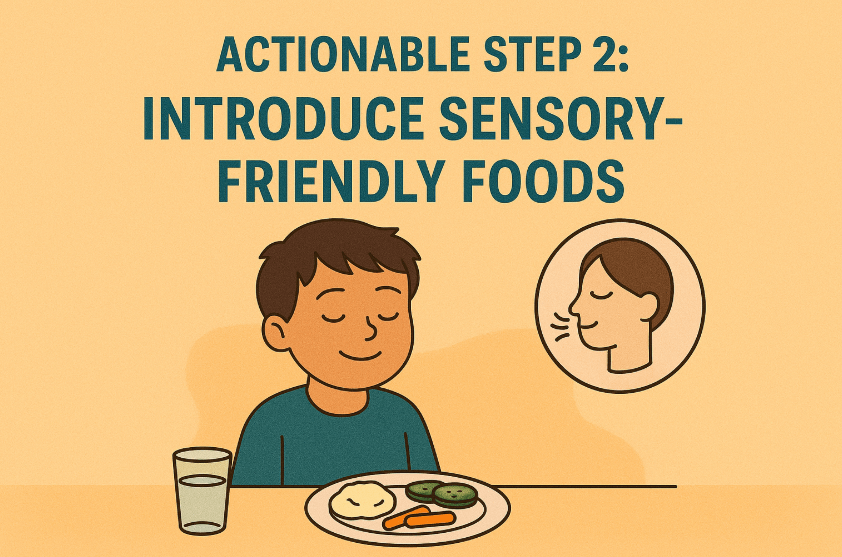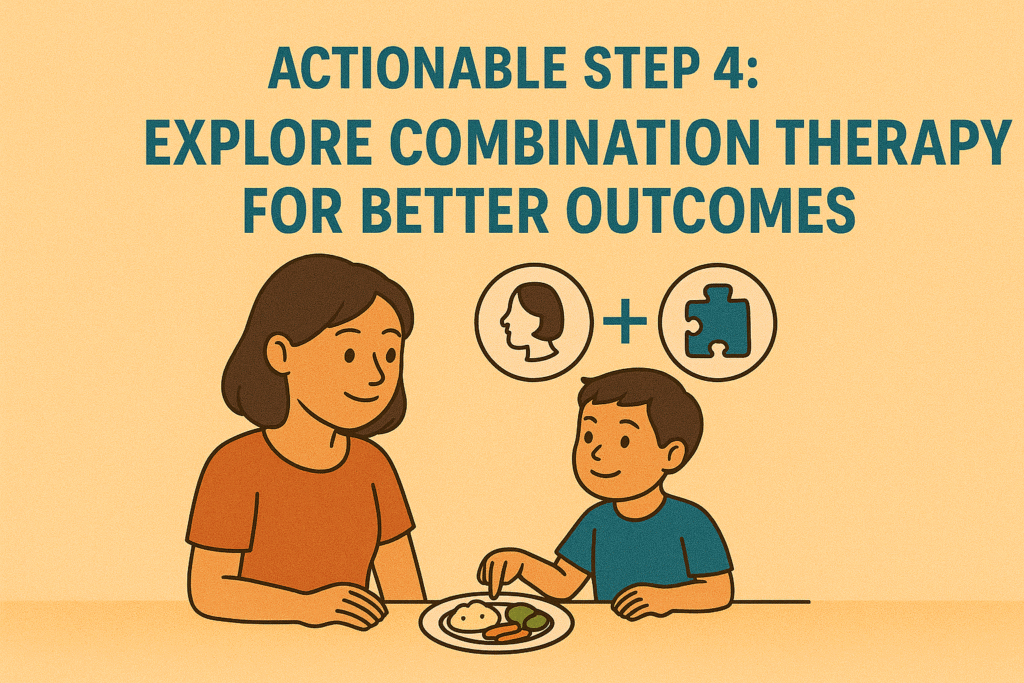Have you ever noticed how some kids will happily eat whatever is on their plate, while for your child, even a single bite can turn into a full battle?
This food battle becomes part of your life, and your autistic child’s eating problems keep coming back, no matter how many therapies or tricks you try.
The worry doubles when you think about their nutrition and the stress it brings to family mealtimes.
So, how to improve the eating habits of a child with autism?
Start by knowing that you don’t need to be stuck with this struggle forever and you have done nothing wrong to make your child hate certain food.
We are here to help you find simple steps that can make mealtimes smoother, reduce your stress, and actually help your child enjoy food a little more.
Why Mealtimes Feel Like a Struggle for Children with Autism

If you are a parent, you already know mealtimes can feel like a daily test of patience. For children with autism, this challenge shows up as picky eating, refusing entire food groups, or pushing away meals because of sensory issues related to eating problems for a child with autism.
Some children with autism may struggle with certain textures, while others become overwhelmed by the smell, color, or even the appearance of food on the plate.
You may be confused as to why these struggles continue even after therapy. The truth is, eating problems are not just about habits. They are closely linked to sensory processing difficulties, where a child’s brain reacts strongly to taste, smell, or texture.
Add to this the behavioral rigidity that many children with autism experience, and it explains why food refusal can persist long after the first therapy sessions.
In India, this problem feels even more intense. Families eat together, and there are cultural expectations for children to enjoy a wide variety of home-cooked meals.
When your child refuses dal, vegetables, or traditional festive foods, the pressure from relatives and even mealtime comparisons with cousins can increase your stress.
How can you improve your autistic child’s eating habits step by step?
These are some practical tips to make mealtime easier for you and your child.
Actionable Step 1: Identify Food Preferences and Triggers

The first step to making mealtimes easier is understanding what your child likes and what they don’t.
Most of the time, children with autism react strongly to textures, smells, or even the way food looks. Some may love crunchy snacks but refuse soft foods, while others might be fine with plain rice but push away anything mixed together.
Steps
Keep a simple journal of what your child eats and how they react. You should note details like the food’s texture, smell, or presentation, and what your child likes and what not.
You will start to notice patterns with time and will understand what works and what doesn’t.
How to act
Start tracking your child’s reaction to food today. Review your notes at the end of the week to see if there are any specific foods or textures that consistently cause problems.
Now you can use this insight to adjust your choices and slowly introduce new foods in ways your child is more likely to accept.
This small practice can go a long way in showing you how to improve an autistic child’s eating and how to help them eat better.
Actionable Step 2: Introduce Sensory-Friendly Foods

This is another tip to solve picky eating in children with autism. Once you understand what your child prefers, the next step is to increase their food choices gradually.
Children with autism reject food due to sensory issues most of the time. They may find the texture of the food wrong, the color may look too bright, or the smell may be too strong.
Here is an example to help you out. Your child may happily eat curd-rice every day but refuse chapati or vegetables. They may hate festive foods like laddoos or kheer, which can cause overwhelm due to sweetness or smell.
Steps
Try to offer them foods that are close to what your child already accepts. For instance, if they like smooth purees, introduce them to another one like that.
Or, if they like rice, try to add mashed potatoes or anything else that is soft and of a similar color.
Remember this: no sudden changes, only gradual changes.
How to act
Pick one calm mealtime this week and introduce just one new food in a very small portion. Pair it with a dish your child already loves, so they feel less pressured. Do it for a while, and these small steps will reduce mealtime battles and give you relief while also addressing your child’s food refusal issue.
Actionable Step 3: Use Behavioral Strategies

You may get better results during mealtimes if you introduce structure and encouragement as part of your child’s mealtime routine.
This means you need to depend on positive reinforcement and consistency to make eating feel less overwhelming for your child.
Steps
Use positive reinforcement and praise your child or smile at them whenever they try a new food, even if it is just a small taste. Establish a structured routine for meals for your child so they know what to expect each day.
How to act
Try setting up a simple reward system today. You can start by creating a sticker chart where your child earns a sticker each time they taste something new.
This will motivate them to try new food.You also need to stick to regular meal times to build that sense of routine in their mind.
These eating strategies for children with autism support calmer, stress-free mealtimes and improve mealtime behavior management for them.
Actionable Step 4: Explore Combination Therapy for Better Outcomes

Sometimes you need to go one step further when you see that even with consistent routines and sensory-friendly meals, progress is slow. In such cases, your child needs a more holistic approach that gives you better meal times.
Step
The extra step is combination therapy, which. This therapy brings together nutritional guidance, behavioral strategies, Ayurvedic therapies, homeopathic treatment, and sensory support to address eating difficulties from all angles.
How to act
If you feel your child needs more structured support, consider speaking with specialists who offer combination therapy plans. Your child needs a personalized program that also includes nutritional assessments.
Single therapies only scratch the surface for many children. That’s why MedicoExperts’ combination therapy, which blends nutritional counseling, behavioral support, and sensory strategies, can create lasting progress.
If you’re ready for structured guidance, our specialists can help tailor a plan to your child’s unique needs.
Benefits
This approach manages surface challenges and also works on the root causes. It tackles sensory sensitivities, behavioral patterns, and nutritional gaps together, and that’s how it gradually improves eating habits and makes mealtimes less stressful for the whole family.
Actionable Step 5: Engage Family Support

You need to bring together all family members to help your child eat better. If the child has a sibling, their sibling can model positive eating behaviors and encourage them to try new foods.
You need to connect with other parents facing similar struggles and get tips from them. They will share what worked for them, and you can learn from them.
Steps
All family members should be there during mealtime. Kids love to follow their siblings, so let siblings show how to taste new foods, and encourage everyone at the table to create a calm and positive atmosphere. Also, use the tips and tricks learned from other parents facing similar situations.
How to act
Start by joining at least one online or local support session this month. There are organizations such as the Autism Society of India that host groups where parents exchange strategies and practical advice. You can join one of these organizations.
Tapping into these networks provides not just guidance but also emotional strength as you try to get help with the mealtime challenges of your child with autism.
Takeaway
You will need patience and understanding to make mealtimes easier for your child and you. Steady but consistent actions will help you more than sudden changes during mealtime. Tackle your child’s preferences first and offer them sensory-friendly foods.
Celebrate small wins by praising and encouraging the child. Do not hesitate to opt for therapies if needed. And most importantly, your family’s help and support will make fighting this challenge much easier.
If feeding your child has become a challenge, we are with you in it. If nothing is working, we are here with our combination therapy that brings together ABA, sensory integration, and nutritional counseling to make your mealtime smoother and healthier.
Contact our specialists today to design a personalized plan for your child and bring more peace to your family’s meals.
Frequently asked questions
Q1. Why does my child with autism refuse to eat certain foods?
Children with autism face sensory sensitivities. The texture, smell, color, or even temperature of food can irritate them. That’s why many of them prefer only a few familiar foods. Gentle exposure and sensory-friendly autism eating strategies for children can slowly expand food variety.
Q2. How do I handle meltdowns during meals?
The first thing you need to do is stay calm and avoid turning meals into a battle. Step back, identify triggers (like certain textures), and try gradually introducing new things to them. Consistency and patience are key in mealtime behavior management with a child with autism.
Q3. Should I consider therapy for my child’s eating issues?
Yes, if eating struggles affect health or family life, you should think about therapy for your child. Occupational therapy, behavioral therapy, or combination therapy (blending behavioral, sensory, and nutritional support) can make a big difference.
Q4. Can picky eating in autism improve with age?
Yes, many children with autism gradually expand their food choices as they grow older and build tolerance to new textures and flavors. But at the same time, you should know that early intervention and gentle strategies can speed up this process.
Q5. Is food aversion in autism linked to gut health?
Research suggests some autistic children may have gastrointestinal issues that make eating uncomfortable. Addressing gut health with professional guidance can sometimes improve eating habits.
Q6. How do I know if my child’s eating problem is sensory or behavioral?
If your child reacts strongly to the texture, smell, or appearance of food, it’s likely sensory. If your child’s refusal is tied to routines, rituals, or seeking control, it may be more behavioral. Mostly, it’s a mix of both.
Q7. Are nutritional supplements necessary for autistic children with limited diets?
Not always. Supplements should only be introduced after consulting a pediatrician or dietitian, as unnecessary use can do more harm than good. A professional assessment helps decide what’s really needed.
Q8. How long should I wait before reintroducing a food my child rejected?
Experts recommend waiting a week or two before trying again. Repeated gentle exposure without pressure can increase acceptance over time.
- https://www.autismspeaks.org/expert-opinion/autism-food-refusal-mealtime-tips
- https://childmind.org/article/autism-and-picky-eating/
- https://pmc.ncbi.nlm.nih.gov/articles/PMC8608248/
- https://pmc.ncbi.nlm.nih.gov/articles/PMC8928840/
- https://www.medicoexperts.com/neurology/autism/
- https://www.medicoexperts.com/neurology/autism/treatment-options/
- https://www.medicoexperts.com/infantile-autism/
- https://www.medicoexperts.com/neurology/autism/types-of-autism/
Recommendations To Understand Different Treatments
Medically Reviewed by MedicoExperts Editorial & Clinical Review Board




